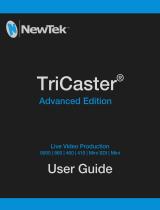
mini-pro Quick Start
Content
Packing Configuration
.....................................................................................................................
4
Product Introduction
........................................................................................................................
5
Key Features
....................................................................................................................................
5
Front Panel
........................................................................................................................................
6
Interface Panel
.................................................................................................................................
7
Dimension
.........................................................................................................................................
8
Install Your Product
..........................................................................................................................
9
Plug in Power
....................................................................................................................................
9
Turn on Your mini-pro
......................................................................................................................
9
Input HDMI Signal Source
..............................................................................................................
9
Connecting HDMI Output
.............................................................................................................
10
Connecting Microphone and External Monitoring Devices
.....................................................
11
Connect USB as a Network Signal Source
................................................................................
11
Connect Computer
.........................................................................................................................
11
Use Your Product
............................................................................................................................
13
Touch Screen Introduction
............................................................................................................
13
Swipe Shortcut
............................................................................................................................
13
Preset Menu
................................................................................................................................
14
Switch Source
................................................................................................................................
15
Switch Effect Setting
..................................................................................................................
16
Switch Duration Setting
.............................................................................................................
16
T-Bar Switch and Multi-screen Preview
.....................................................................................
17
PIP
....................................................................................................................................................
18
PIP Layout Setting
.....................................................................................................................
18
PIP Layer Setting
.......................................................................................................................
18
Load and Save
...............................................................................................................................
20
Output Setting
................................................................................................................................
21
HDMI Output
...............................................................................................................................
21
USB3.0 Output
............................................................................................................................
22
Audio
................................................................................................................................................
22
Chroma Key
....................................................................................................................................
24
Logo
.................................................................................................................................................
26
PTZ
..................................................................................................................................................
26
Record
.............................................................................................................................................
27
Streaming
..........................................................................................................................................
29
YouTube Streaming
.......................................................................................................................
29
Facebook Streaming
.....................................................................................................................
30
Zoom Streaming
............................................................................................................................
31




















